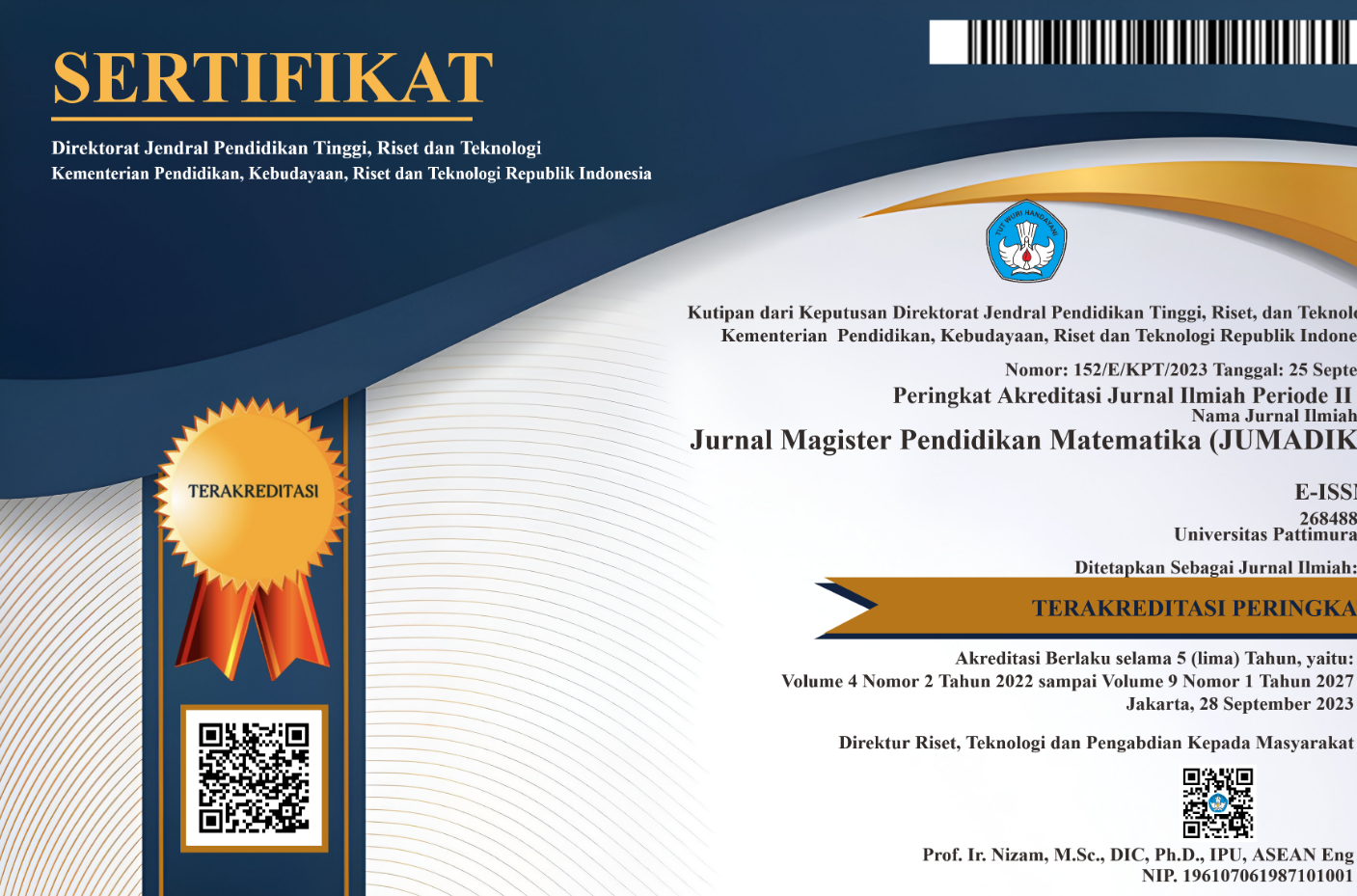ANALISIS KEMAMPUAN BERPIKIR LOGIS MATEMATIS SISWA PADA MATERI SISTEM PERSAMAAN LINEAR DUA VARIABEL
Abstract
This study aims to describe the mathematical logical thinking ability of students of SMP Negeri 1 Ternate on systems of linear equations in two variables materials. This research uses a qualitative research. Subject of this study were three students of class VIII-J SMP Negeri 1 Ternate. The data collection stage was conducting tests, categorizing students according to the KBLM level based on the test results, and conducting interviews with research subjects. The data analysis used in this study was to analyze the data from the test results and interviews. The results showed that students at KBLM Level 2 were able to say and write down what was known and what was asked about the questions correctly, were able to use the steps to solve systems of linear equations in two variables and these steps were correct, were able to provide arguments about all steps-steps to solve systems of linear equations in two variables, and be able to draw conclusions correctly on the final answer. Students at KBLM Level 2 were able to say and write down what was known and not write down what is asked, able to use the steps to solve systems of linear equations in two variables and these steps are correct, able to provide arguments about all steps to solve systems of linear equations in two variables, and able to draw conclusions correctly on the final answer. Students at KBLM Level 2 were able to say and write down what was known and not write down what is asked, can use the steps to solve systems of linear equations in two variables but make calculation errors in these steps, do not provide arguments about all the steps solve systems of linear equations in two variables, and do not draw conclusions correctly on the final answer
Downloads
References
Andriawan, B & Budiarto, M.T. (2014). Identifikasi Kemampuan Berpikir Logis Dalam Pemecahan Masalah Matematika Pada Siswa Kelas VIII-1 SMP Negeri 2 Sidoarjo. MATHEdunesa, 3 (2), 42-48.
Evitasari, I. P. (2017). Kemampuan Pemecahan Masalah Sistem Persamaan Linier Dua Variabel Ditinjau Dari Kecerdasan Logis Matematis dan Gender. Prosiding Seminar Nasional Integrasi Matematika dan Nilai Islami 2017, 617-621. Malang: UIN Maulana Malik Ibrahim.
Fitriyah, D. M., Indrawatiningsih, N., & Khoiri, M. (2019). Analisis Kemampuan Berpikir Logis Matematis Siswa SMP Kelas VII dalam Memecahkan Masalah Matematika Ditinjau dari Gaya Belajar. JEMS (Jurnal Edukasi Matematika dan Sains), 7(1), 1-14.
Puspitasari, I. W., Fauzan, G. A., & Bernard, M. (2019). Penerapan PBL Dengan RME Berbatuan Software Geogebra untuk Meningkatkan Kemampuan Berpikir Logis Matematik Siswa SMP. Journal On Education, 1 (4), 679-687.
Rahmawati, K. N., & Kurniasari, I. (2016). Profil Berpikir Logis Siswa Dalam Memecahkan Masalah Matematika Menggunakan Test Of Piaget’s Logical Operations (TLO) Ditinjau Dari Kemampuan Matematika. MATHEdunesa, 3 (5), 200-209.
Saragih, S. (2007). Mengembangkan Kemampuan Berpikir Logis Dan Komunikasi Matematik Siswa Sekolah Menengah Pertama Melalui Pendekatan Matematika Realistik. Disertasi. Bandung: Universitas Pendidikan Indonesia.
Sholiha, N. (2011). Kemampuan Berpikir Logis Siswa dalam Pemecahan Masalah Matematika Siswa Kelas VII-C SMP Negeri 12 Surabaya. Skripsi tidak dipublikasikan. Surabaya: Universitas Negeri Surabaya.
Siswono, T. Y. E. (2008). Model Pembelajaran Berbasis Pengajuan dan Pemecahan Masalah Untuk Meningkatkan Kemampuan Berpikir Kreatif. Surabaya: Unesa University Press.
Sumarmo, U, dkk. (2012).Kemampuan Dan Disposisi Berpikir Logis, Kritis, Dan Kreatif Matematik (Eksperimen Terhadap Siswa Sma Menggunakan Pembelajaran Berbasis Masalah Dan Strategi Think-Talk-Write). Jurnal Pengajaran MIPA, 17 (1), 17-33.
Usdiyana, D., Purniati, T., Yulianti, K., & Harningsih, E. (2009). Meningkatkan Kemampuan Berpikir Logis Siswa Smp Melalui Pembelajaran Matematika Realistik. Jurnal Pengajaran MIPA, 13 (1), 1-14.
Yulianto, G. D, Suastika, I. K., & Fayeldi, T. (2019). Analisis Kemampuan Pemecahan Masalah Matematika Berdasarkan Langkah Polya Pada Materi Sistem Persamaan Linear Dua Variabel. Pi: Mathematics Education Journal, 2 (1), 7-13.
Copyright (c) 2020 Mustafa A H Ruhama, Nurya Yasin, Karman La Nani

This work is licensed under a Creative Commons Attribution-NonCommercial-ShareAlike 4.0 International License.
License and Copyright Agreement
In submitting the manuscript to the journal, the authors certify that:
- They are authorized by their co-authors to enter into these arrangements.
- The work described has not been formally published before, except in the form of an abstract or as part of a published lecture, review, thesis, or overlay journal. Please also carefully read Jurnal Magister Pendidikan Matematika (JUMADIKA) Posting Your Article Policy.
- That it is not under consideration for publication elsewhere,
- That its publication has been approved by all the author(s) and by the responsible authorities – tacitly or explicitly – of the institutes where the work has been carried out.
- They secure the right to reproduce any material that has already been published or copyrighted elsewhere.
- They agree to the following license and copyright agreement.
Copyright
Authors who publish with Jurnal Magister Pendidikan Matematika (JUMADIKA) agree to the following terms:
- Authors retain copyright and grant the journal right of first publication with the work simultaneously licensed under a Creative Commons Attribution-NonCommercial-ShareAlike 4.0 International License (http://creativecommons.org/licenses/by-nc-sa/4.0/) that allows others to share the work with an acknowledgment of the work's authorship and initial publication in this journal.
- Authors are able to enter into separate, additional contractual arrangements for the non-exclusive distribution of the journal's published version of the work (e.g., post it to an institutional repository or publish it in a book), with an acknowledgment of its initial publication in this journal.
- Authors are permitted and encouraged to post their work online (e.g., in institutional repositories or on their website) prior to and during the submission process, as it can lead to productive exchanges, as well as earlier and greater citation of published work.








